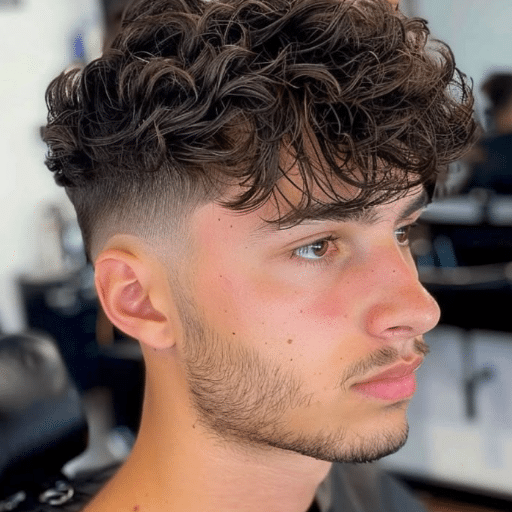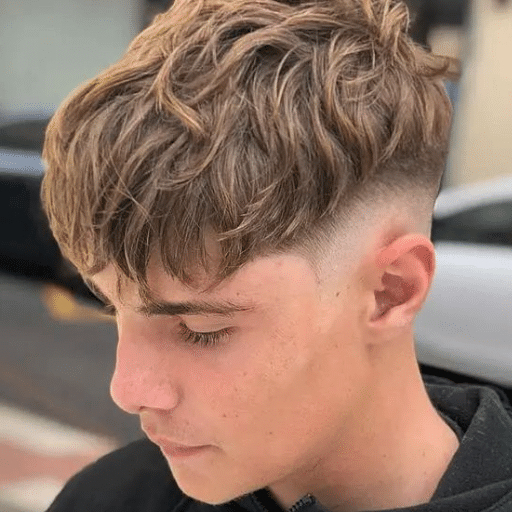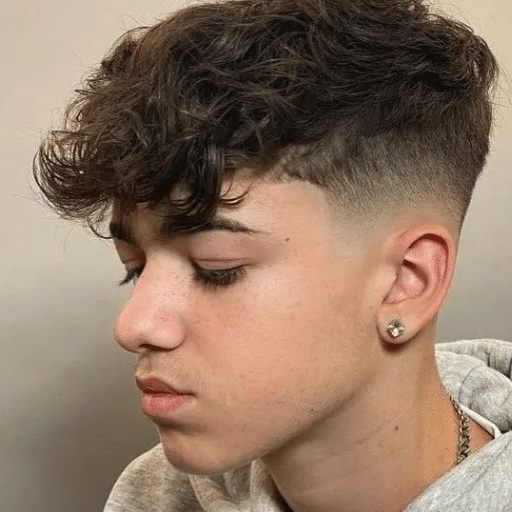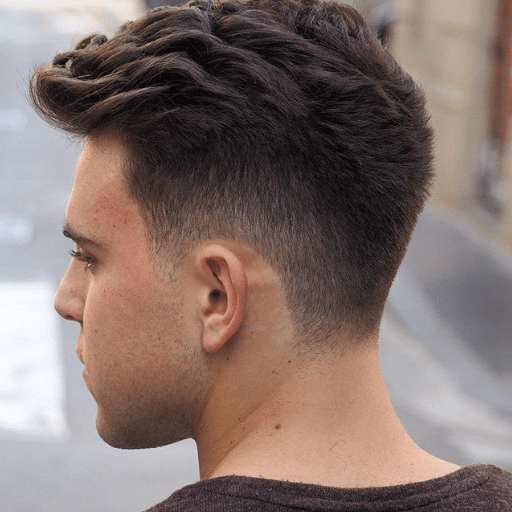The textured fringe is now a very popular hairstyle that captures the essence of looking edgy, yet versatile at the same time. The reason why this haircut has become so popular is due to its design flexibility, being appropriate for all hair types, faces, and even user preferences. Moreover, the aim can also be adding volume, framing the face, or even a mixture of all with a modern take on classic styles, and the textured fringe does all of the above remarkably. In this article, we will further understand the nature and attributes of a textured fringe, why it has gotten so popular, and additionally provide guide-like suggestions on styling to achieve this trendy haircut. So, with that in mind, let’s get started and elevate your hairstyle with this effortless and customizable haircut.
What is a Textured Fringe and Why is it Popular?

A textured fringe is a modern hairstyle created using a layered and shaggy look and strands that have been unevenly cut to give it an illusion of depth. Unlike other shag styles and uneven cuts, the fringe base of this cut allows it to complement all hair types and faces, broadening its appeal. Textured fringes have been rising in demand because they inevitably have to be constructed with volume, making them catchy and appealing to the eyes, as always balanced. Unlike most hairstyles, casuals and formals both go hand in hand with this hairstyle, making it appropriate for all places.
Also, it makes the face look younger, highlights facial features, and shapes everything beautifully. As one of the contemporary hairstyling trends, the textured fringe is appealing due to its effortless style as well as personal adaptability.
Understanding the Texture in a Fringe Haircut
In my opinion, the correct texture in a fringe haircut comes from achieving movement and depth in the hair. Adding texture through point cutting, razor cutting, or texturizing shears, which soften the edges and remove bulk, helps achieve this. This way, the fringe blends with the hair and has some freedom in how it is styled. By adjusting the amount of texture based on the shape of the face and personal preferences, the fringe can be tailored to accentuate major defining features and improve holistic beauty. The reasoning behind adding texture is to balance precision and work in an effortless manner to ensure the haircut feels modern and tailored.
The Rise of Textured Fringe Hairstyles in Fashion
Modern readers and movie watchers have witnessed the increasing fashion dialogue around textured fringe hairstyles and their application. I assume this change is brought about due to frame dimension and the detailing required to slim one’s features. To a certain degree, fringe styles can be texturized to match hair and face shapes with a personal touch that enhances the impression. Also, they can be accessorized to be worn from formal to casual settings, which marks their importance in modern hairstyling.
Benefits of a Textured Fringe Haircut
A textured fringe haircut has many benefits, which improve both functionality and style. Firstly, it is very versatile and works for different lengths, hair types, and faces. The layers in the fringe are effortless to shape, adding movement and volume, helping to frame the face and lift features without looking too done up. This is perfect for people who want to soften angular jawlines or are seeking to balance out proportions. Moreover, textured fringes are easy to style and are suited to many occasions; they require minimal maintenance and work well when cut to grow out trim, minimizing salon trips. Currently, fashion trends embrace casualness or sleek polish, both of which can be achieved with this haircut while keeping style and functionality.
How to Choose the Right Textured Fringe Haircut for Your Face Shape

How a fringe complements your proportions is critical in selecting the perfect textured fringe haircut for your face shape. For oval faces, almost any fringe is flattering, especially softer, wispy ones that lend further balance. Round face shapes are framed best by longer and side-swept fringes, which add length and define more angular proportions. Light, textured fringes for square faces can add balance by softening prominent jawlines and adding some grace, bringing a more gentle feel to the face. Heart-shaped faces usually benefit from fringes that are more voluminous or longer towards the sides, which help in countering a narrower jaw. Long face shapes are best suited to bangs that sit just below the brow to create horizontal width while minimizing vertical focus. A stylist consultation helps ensure the customization of your individual traits and preferences.
Determining Your Face Shape for the Perfect Fringe
To determine your face shape for the ideal fringe, I suggest looking at your hairline and jawline, and the ratio between the width and length of your face. If your forehead is broader than the jawline and your chin is gently pointed, you possess a heart-shaped face. Look for commanding angular jaws with equal proportions between the brow and chin for a square face. The oval face exhibits proportionate balance with a hint of length. For the long face shape, the vertical measurement overshadows the width prominence.
If you don’t pinpoint your exact shape, looking at side-by-side images of common face shapes or consulting with a stylist can be helpful. Keep in mind that the most suitable fringe enhances your distinctly natural features, so face shape should just be a point of reference. Doing so empowers you to achieve harmonious proportions and a beautiful silhouette.
Matching Textured Fringe Styles with Your Profile
As I match the pixie and the textured fringe styles with my profile, my consideration is to maintain a radius of features and preferences resemblance. Let’s say my face is round. In that case, I would go for longer tapered edge fringes because they are quite effective in lengthening and slimming the face visually. For an oval face, picking up soft layered fringes should do the job as they tend to accentuate the symmetry in proportions. If my face is angular or square, I would prefer fringes that incorporate softness and textural detail to mask the sharp lines. It is important to know how the length, density, and texture of the fringe relate to my profile. That is basic, but personalizing the style is something I would gladly spend time on.
The Role of Hair Length and Texture in Choosing a Fringe
When seeing the importance of hair length, hair texture, and a fringe bang, I examine how these elements work together to achieve a desired outcome. With shorter hair, I find that blunt or wispy fringes add shape and define features. With medium-length hair, curtain or side-swept bangs are both flattering as they highlight the face and integrate with the hair’s movement. For longer hair, I prefer a longer textured fringe that is dynamic to create balance and prevent weightiness. Texture also matters a lot; if my hair is fine, I might choose soft, gentle fringes that bring volume, while thicker hair usually accommodates bolder, fuller fringe cuts. Matching the fringe with my hair length and texture ensures I achieve a polished look.
How to Style a Textured Fringe for Different Occasions

With the right products and some techniques, styling a textured fringe can fit many events. For informal occasions, a light mousse or texturizing spray works best to highlight the fringe’s movement and give a relaxed, tousled look. For professional and formal occasions, the fringe may be polished by smoothing with a flat iron and applying styling cream. If preparing for an updo, soft waves can be added to the fringe with a curling iron for a sophisticated and elegant look. Smooth, layered finishes, the right tools, and products will ensure a textured fringe looks appropriate for all occasions.
Everyday Textured Fringe Styles for a Casual Look
The secret to achieving a casual textured fringe is to embrace easy styling methods that work with the hair’s natural texture. Apply a lightweight texturizing spray or mousse onto damp hair to enhance the fringe and use either air drying methods or a blow dryer with a diffuser on low heat for shape. For definition, gently curl dry fringe sections with your fingers. Use matte hair wax or pomade if needed to separate strands for a more carefree hold. This method results in a styled fringe that can be worn daily and looks effortless.
Using Cream and Spray for a Neat Finish
When finishing with cream and spray, I begin with a lightweight styling cream that matches my hair type. After dispensing an appropriate amount, I apply it to damp or air-dried hair to control and smooth the fringe and flyaways. Once the styling cream is set, I spray a light, flexible hold hairspray to preserve the style without crystallizing it. The result is a polished look with soft, refined control and a natural feel.
Achieving a Polished Blowout with Your Fringe
Getting a polished look on my fringe starts with a good ‘wash and go’ routine. I always use thickening shampoos and conditioners to ensure that my fringe is both smooth and easy to manage. After towel drying my hair, I always put on a heat protectant to guard against any smoothing serums used later. Starting with the fringe, I curl it under with a round brush and blow-dry on medium heat. Finishing touches to my blowout start with precision styling where I shine by using the cool shot at the end, which ensures my style is not only locked but also ad a glimmer. I finish my fringe off with serums and smoothing creams to say goodbye to untamed strands for a trim fringe that looks fresh.
Can Men Rock a Textured Fringe Haircut?

Of course, men can sport a textured fringe hairstyle as it is one of the most stylish and versatile options for hair. This haircut is best suited for wavy hair, straight hair, and even curly hair, giving a laid-back yet sophisticated look. The fringe gives the hair some character while accentuating the hair, and is easy to maintain, requiring only a small amount of product to style. It looks great with a fade, taper, or undercut and works seamlessly with both formal and casual looks. It is one of the best options for modern men’s hairstyles.
Exploring Men’s Textured Fringe Options
During my assessments for the right style of textured fringe, I make sure to evaluate hair thickness, face shape, and maintenance level. The balance of movement for thicker hair lies in heavier, layered fringes, while a choppier texture works to create volume on finer hair. Height fringes add to round faces while softer tapering suits square or angular faces, rounding out the squared edges. Understanding the time one puts into preening is also something I take into consideration—low maintenance options easy with product and effort, while more intricate designs require daily upkeep. In this case, styling becomes a unique combination designed for the individual.
Tips for Maintaining Men’s Textured Fringe
Here are some unwritten rules that are easy as breathing yet effective for shaping a man’s textured fringe hairstyle:
Getting a trim regularly within 4-6 weeks will keep the shape, enhance the criteria needed, and provide texture without taking its sharpness away.
Using lightweight products like clay and sea salt sprays will maintain and enhance the texture while ensuring no heaviness, unlike gels or shining products designed to conceal one’s natural look.
Blow-Drying Technique: Once you finish washing your hair, a blow dryer set to medium or low heat may be used. Ensure that the blow dryer is angled towards the scalp to lift the hair and create volume. Styling with a round brush helps keep the hair in place.
Maintain a Good Haircare Routine: Hair requires shampooing using a conditioner and shampoo that is free from sulfates to help maintain its moisture and prevent damage. Proper maintenance of hydration helps in keeping the fringe supple and easier to style.
Adapt to Your Hair Type: Products that define curls should be used on curly hair. Straight hair looks better when styled with volumizing products.
Avoid Over-Washing: For most people, washing their hair 2 or 3 times a week is ideal. Washing more frequently will strip the hair of its natural oils, resulting in dryness, which makes managing the fringe challenging.
Incorporating these practices into your daily routine will allow you to retain the shape, volume, and styled appearance of your textured fringe, allowing it to look effortlessly polished.
Popular Fringe Hairstyles for Men and How to Achieve Them
All types of hair benefit from a textured fringe, which remains a versatile option for achieving a classic look. You can arrive at this look by applying a lightweight styling product while the hair is still damp, and either using a comb or your fingers to shape the fringe as it falls. For a more contemporary look, the cropped fringe style is another option. With this style, the fringe is cut off straight, which can be further enhanced with a matte finish product for a sharper look. Movement can be added with the swept fringe, which is achieved with blow-drying the fringe to the front and sideways with a texturizing spray at the roots for added bounce and hold. Whatever style you go for, regular haircuts alongside quality hair products will make a big difference.
What are the Best Texturizing Techniques for a Fringe?

The desired shape is kept while dimension and bulk is reduced, achieving effective texturization. One way this can be done is through point cutting, which is perhaps the most popular option, where the scissors are angled into the fringe to soften the blunt edge and have the cut ‘grow out’ for a more natural appearance. Alternatively, razor cutting provides movement and softness, making the fringe look wispy and feathered. In addition, thinning shears are effective in reducing volume in very thick fringes so that they are able to lie flatter against the forehead. In addition, considering hair type, density, and other hair styles to complement features is crucial for providing the best results. Each individual technique must be adjusted to suit personal preferences. How To Make A Polish Fringe
Professional Techniques for a Defined Fringe
Achieving a polished and defined fringe entails focus and flexibility in my methods. Clients’ hair density, type, and texture influence their tailor-made approach. Depending on the desired look, I either apply scissor-over-comb techniques for precision or use point cutting to blend softer finishes. Thicker hair requires the use of thinning shears to allow for weightless movement. Every fringe is customized to frame, sharpen, or soften the client’s features effortlessly, blending with preferred style choices.
How to Use a Comb to Enhance Your Fringe’s Texture
To better the texture of your fringe with a comb, my main focus is on the technique as well as the tool, starting with a precise fine-toothed comb or a wide-toothed one for softer separation. It is important to note that while using a wide-tooth comb, the comb will create a more natural separation, which cannot be undone. While lifting the fringe from the roots to create slight volume, I direct the strands where I want them. For better texture, I lightly backcomb the fringe’s base to gently smooth out the surface, which gives the illusion of fluff. When I want to accentuate the hair movement, I define the flow and layers, giving a light spray of texturizing spray to shape and movement to use while styling. Keeping in mind the client’s hairstyle and preferences ensures that whatever finish I choose to go with will suit the style and flow of the client’s hair, while making it possible to adapt it depending on the client’s needs.
Choosing the Right Hair Products for Your Fringe
It is important to look at your hair type, texture, and the style you want when choosing hair products for your fringe. A volumizing mousse or spray would help fine or thin hair as it would give lift without weighing the fringe down. Coarser and thicker hair types would benefit from smoothing serums or creams, which help control frizz as well as improve manageability. For better definition and structure, use a lightweight wax or texturizing spray that allows movement to keep the fringe dynamic while providing support. Always use products that would suit your fringe and bring out its natural flow while blending with the rest of the hairstyle.
References
-
A complete guide to textured fringe hairstyles – This article discusses the growing popularity of textured fringes, their benefits, and styling tips.
-
Should I get a textured fringe? – A Reddit thread where users share advice and experiences about textured fringe hairstyles.
-
Straight to Messy Textured Hair in 3 Minutes: A Step-by-Step – A YouTube tutorial demonstrating how to style a messy textured fringe effectively.
Frequently Asked Questions (FAQ)
Q: What is a textured fringe haircut?
A: A textured fringe haircut involves cutting the hair at the bottom of the fringe to create layers and dimension. This hairstyle is versatile and can be adapted to various lengths and textures, making it suitable for different shapes of your head.
Q: How can a fade enhance a textured fringe haircut?
A: A fade can enhance a textured fringe haircut by creating a seamless transition from the short hair on the sides to the longer textured fringe on top. This contrast adds depth and interest to the overall hairstyle.
Q: What should I tell my barber to get a trendy textured fringe haircut?
A: When visiting your barber, ask for a textured fringe with layers that suit the shape of your head. Mention if you want a fade on the sides or any specific length, such as an inch of fringe or short hair for easy maintenance.
Q: How often should I visit my hairdresser to maintain a textured fringe?
A: To keep your textured fringe looking sharp and to ensure it holds its shape, visit your hairdresser every 4-6 weeks. Regular trims will prevent the fringe from becoming too heavy or losing its defined shape as your hair grows.
Q: Can a textured fringe haircut work for Asian hair types?
A: Yes, a textured fringe haircut can work wonderfully for Asian hair types. The haircut can be adapted to suit the hair’s natural texture and density, which often allows the fringe to hold its shape well.
Q: Is a textured fringe haircut suitable for mens hairstyles?
A: Absolutely, a textured fringe is a popular choice for mens hairstyles. It adds a modern and stylish touch, allowing for various styling options depending on personal preference and the shape of your head.
Q: How can I style a textured fringe haircut at home?
A: To style a textured fringe at home, apply a light styling treatment to damp hair and use your fingers to let your hair fall naturally. For added volume, you can use a blow dryer and a round brush to lift the fringe slightly.
Q: What face shapes are best suited for a textured fringe haircut?
A: A textured fringe can be tailored to complement most face shapes, including oval, round, and square. The layers and length can be adjusted to enhance or soften the natural shape of your head.





